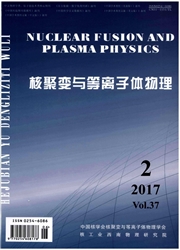

 中文摘要:
中文摘要:
采用分子动力学方法模拟200eV的CH3粒子轰击到不同基底温度的钨样品上,分析了C、H原子在钨表面的沉积、散射及溅射情况,结果表明C、H原子的沉降量均随入射剂量的增加而增加。在基底温度为100K时,相同入射剂量下沉积的C原子最多,而当基底温度为1200K,在入射剂量大于1.5×1016cm-2时,C原子的沉降量小于其它基底温度下的C的沉降量。CH3在轰击样品时发生了分解,各种分解情况随基底温度变化较小,其中不同基底温度下一级分解率在40%上下波动,二级分解在23%左右,而完全分解的CH3在9%左右。C、H原子的散射角主要分布在5°-85°间,散射C原子分布的最大值分布在40°-50°或50°-60°间,散射C原子分布的最小值分布在0°-10°或80°-90°间;而不同基底温度下散射 H 原子分布的最大值均在40°-50°间,最小值均在0°-10°间。散射C原子的能量在0-140eV之间,散射能量为0-120eV的C原子占散射总量的98%以上,散射C原子平均能量随基底温度的增加而增加,其变化从65.5eV 增加到68.5eV;散射 H 原子的能量也在0-140eV 之间,但大约70%的散射H原子能量在40eV以内,散射平均能量随基底温度的增加而减小,其变化从13.92eV减小到13.05eV。
 英文摘要:
英文摘要:
The molecular dynamics simulations of interactions between CH3 and tungsten materials of different temperature are carried out, based on the reactive empirical band order function to understand the possible mechanisms of C, H deposition and sputtering on the first wall in fusion device. The energy of incident CH3 particle is 200eV. The simulated results show that the deposition atoms of C and H increase with incident particle increasing, when substrate temperature is 100K the deposition of C atoms was more than others temperatures’, and when the substrate temperature is 1200K, the incident is greater than 1.5×1016cm-2, the deposited C atoms is less than other substrate temperatures’ deposited C atoms. CH3 was decomposed during CH3 bombardment with substrate, about 9% of the CH3 was completed decomposition; about 40% of the CH3 was decomposited to CH2 and H;about 23%of the CH3 was decomposited to CH and 2H. The scattering angle of C and H atoms are mainly distributed between 5° and 85°, the distribution of scattering angle maximum of C atom was 40°-50° or 50°-60°, the minimum distribution of C atom at between 0° and 10° or between 80° and 90°;the energy of scattered C atoms is between 0 and 140eV, more than 98%scattering atoms is between 0 and 120eV among of them, and the average scattering energy increases with the increase of substrate temperature, from 65.5eV increased to 68.5eV, The distribution maximum of H atom was 40°-50°, the minimum distribution of H atom at between 0° and 10°. Scattering energy of H atom is between 0 and 140eV, but about 70%of the scattering H atomic energy within 40eV, the average scattering energy decreases with the increase of substrate temperature, from 13.92eV decreased to 13.05eV.
 同期刊论文项目
同期刊论文项目
 同项目期刊论文
同项目期刊论文
 期刊信息
期刊信息
